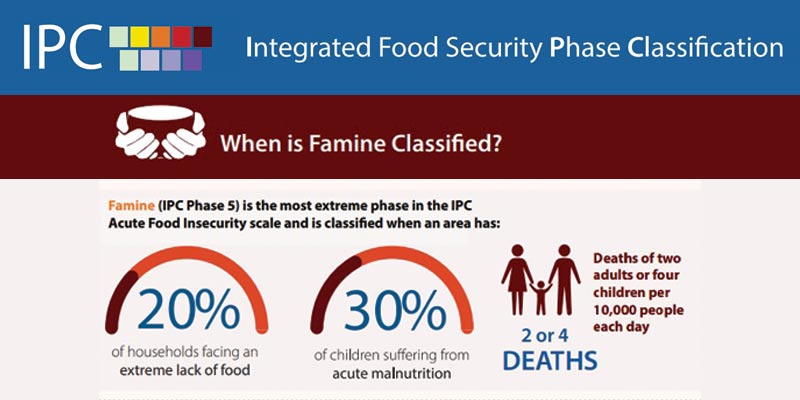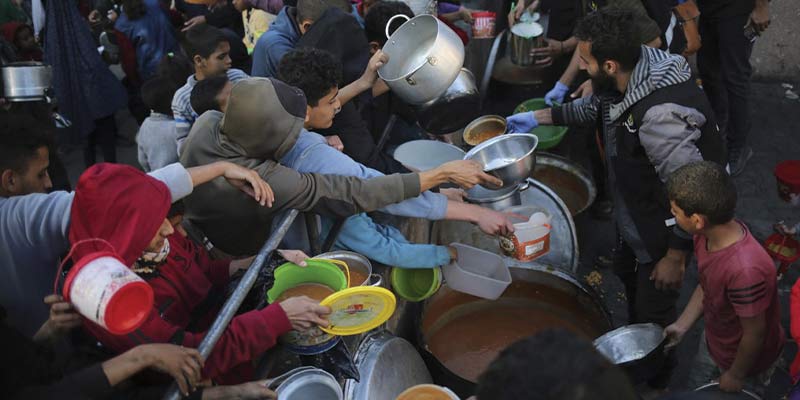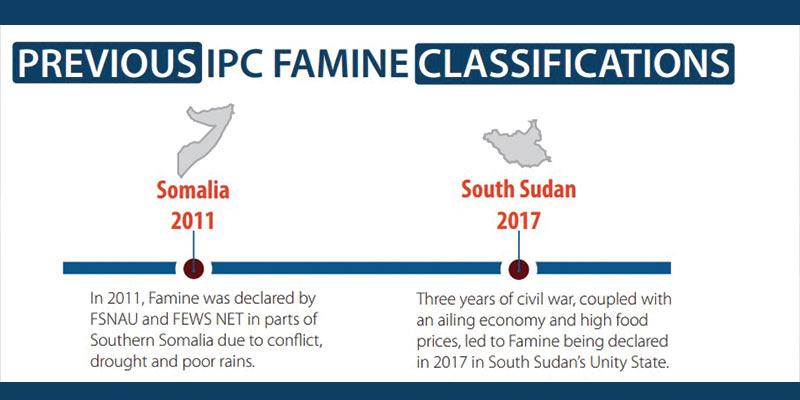- World
- Mar 19
Explainer - Integrated Food Security Phase Classification (IPC)
• Famine is imminent in the northern part of the Gaza Strip and the entire population of Gaza is facing crisis levels of food insecurity or worse, according to the new Integrated Food Security Phase Classification (IPC) report released on March 18.
• Overall, 1.1 million people in Gaza – half of the population – have completely exhausted their food supplies and coping capacities and are struggling with catastrophic hunger (IPC Phase 5) and starvation.
• This is the highest number of people ever recorded as facing catastrophic hunger by the IPC system, and double the number in IPC Phase 5 just three months ago.
• In Gaza’s two northern governorates, where around 300,000 people remain trapped, famine is expected to arrive between now and May.
• The famine threshold for acute food insecurity has already been far exceeded, while acute malnutrition among children below five years is proceeding at record pace towards the second famine threshold.
• Non-trauma mortality – the final famine indicator – is accelerating, but data remains limited, as is typical in war zones.
• Before the recent months’ hostilities, 0.8 per cent of children under five years of age were acutely malnourished. The latest report shows that as of February in the northern governorates, that figure is between 12.4 and 16.5 per cent.
• Without a significant and immediate increase in deliveries of food, water and other essential supplies, conditions will continue deteriorating. Virtually all households are already skipping meals every day and adults are reducing their meals so that children can eat.
• The World Food Programme (WFP) estimates that simply addressing the basic food needs will require at least 300 trucks to enter Gaza every day and distribute food, especially in the north. WFP has only managed to take nine convoys to the north since the start of the year.
• Dispatching aid to the north of Gaza needs day-to-day approvals from Israeli authorities. During the long waits at the Wadi Gaza checkpoint, truck convoys face looting and are frequently turned back. If they do get through, there is a high risk of more looting along the difficult route north.
• The current situation will have long-term effects on the lives and health of thousands. Right now, children are dying from the combined effects of malnutrition and disease.
• Malnutrition makes people more vulnerable to getting severely ill, experiencing slow recovery, or dying when they are infected with a disease.
• The long-term effects of malnutrition, low consumption of nutrient-rich foods, repeated infections, and lack of hygiene and sanitation services slow children’s overall growth. This compromises the health and well-being of an entire future generation.
Integrated Food Security Phase Classification (IPC)
• The Integrated Food Security Phase Classification (IPC) is an innovative multi-stakeholder initiative to improve analysis and decision-making on food security and nutrition.
• Using the IPC classification and analytical approach, governments, UN agencies, NGOs, and other stakeholders work together to determine the severity and extent of acute and chronic food insecurity and acute malnutrition situations within countries, according to internationally recognised standards.
• The IPC was developed in 2004 by the Food Security and Nutrition Analysis Unit (FSNAU), managed by the Food and Agriculture Organisation of the United Nations (FAO) in Somalia.
• The request for a food security measurement tool was motivated by a growing need for rigorous, evidence-based, consensus-based and actionable food security information to facilitate an effective humanitarian response in the Somali context.
• The IPC became more widely applicable in the following years, as it served as a “common currency” for food security and nutrition analysis.
• Since its inception, the IPC initiative is now described as the ‘global standard’ for classifying acute food insecurity and malnutrition affecting millions globally.
• The IPC has proved to be one of the best practices in the global food security field, and a model of collaboration in over 30 countries in Latin America, Africa and Asia.
IPC Classification System
• The IPC Classification System distinguishes and links Acute Food Insecurity, Chronic Food Insecurity and Acute Malnutrition to support more strategic and better coordinated responses.
• The protocols used by the IPC are harmonised across the three individual scales (IPC Acute Food Insecurity, IPC Chronic Food Insecurity, and IPC Acute Malnutrition).
• This allows for the analysis of linkages between the three conditions and the possibility of detangling acute food insecurity, chronic food insecurity and acute malnutrition, in support of a more strategic response analysis.
IPC classifies the severity of Acute Food Insecurity into five severity phases:
i) None/Minimal - Households are able to meet essential food and non-food needs without engaging in atypical and unsustainable strategies to access food and income.
ii) Stressed - Households have minimally adequate food consumption but are unable to afford some essential non-food expenditures without engaging in stress coping strategies.
iii) Crisis - Households either have food consumption gaps that are reflected by high or above-usual acute malnutrition; or are marginally able to meet minimum food needs but only by depleting essential livelihood assets or through crisis-coping strategies.
iv) Emergency - Households either: have large food consumption gaps that are reflected in very high acute malnutrition and excess mortality; or are able to mitigate large food consumption gaps but only by employing emergency livelihood strategies and asset liquidation.
v) Catastrophe/Famine - Households have an extreme lack of food and/or other basic needs even after full employment of coping strategies. Starvation, death, destitution and extremely critical acute malnutrition levels are evident. For famine classification, the area needs to have extreme critical levels of acute malnutrition and mortality.
IPC Famine classification
• The IPC sets the global standards for Famine classification.
• The IPC plays a critical role in identifying Famine conditions, and informing the response needed to save millions of lives.
• Famine is the most severe phase of the IPC.
• The Integrated Food Security Phase Classification (IPC) defines Famine as an extreme deprivation of food. Starvation, death, destitution and extremely critical levels of acute malnutrition are or will likely be evident.
A Famine classification (IPC Phase 5) is the highest phase of the IPC Acute Food Insecurity scale, and is attributed when an area has:
a) At least 20 per cent of the population in that particular area are facing extreme levels of hunger.
b) At least 30 per cent of children suffering from acute malnutrition.
c) Two deaths for every 10,000 adults and four deaths per 10,000 children daily due to outright starvation.
• The IPC does not “declare Famine” or issue “Famine declarations”, but rather facilitates the analysis that allows governments, international/regional organisations and humanitarian agencies to issue more prominent statements or declarations.
• The last decade has witnessed two examples of famine classification, in Somalia in 2011 and in South Sudan in 2017, that resulted in widespread acute malnutrition and the deaths of tens of thousands of people.
• The famines in Somalia and South Sudan were extreme food crises in which large populations lacked adequate access to food, mainly driven by conflict and erratic weather patterns.
Recommendations from the IPC for Gaza
• Famine can be halted — both in the immediate term and it requires urgent and proactive measures from parties to the conflict and the international community.
• They must immediately curb the rapidly escalating hunger crisis in the Gaza Strip, garner political support to put an end to the hostilities, mobilise necessary resources and ensure the safe delivery of humanitarian aid to the people of Gaza.
Overall recommendations:
i) Restore humanitarian access to the entire Gaza Strip.
ii) Stop the fast-paced deterioration of the food security, health and nutrition situation leading to excess mortality through: the restoration of health, nutrition, and WASH (water, sanitation and hygiene) services and the protection of civilians; and the provision of safe, nutritious, and sufficient food to all the population in need.
iii) The sustained supply of sufficient aid commodities, including but not limited to food, medicines, specialist nutrition products, fuel, and other necessities should be allowed to enter and move throughout the entire Gaza Strip by road. Traffic of commercial goods should also be fully resumed to meet the volume of commodities required.
Manorama Yearbook app is now available on Google Play Store and iOS App Store



